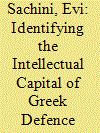| Srl | Item |
| 1 |
ID:
095204


|
|
|
|
|
| Publication |
2010.
|
| Summary/Abstract |
The authors look at different aspects of China's innovation development that accelerated significantly in recent years. As the country is making a transition from a purely export model to a model centered on domestic demand, its economy is restructured, imported technologies are replaced with domestic innovations, and its companies are making investments in the rest of the world in an effort to obtain new manufacturing and management technologies. All these developments are largely at the root of China's successful anti-crisis strategy, and the world crisis will become a further stimulant contributing to the fulfillment of the objective set in 2006 - turning China into an innovation-driven country by 2020.
|
|
|
|
|
|
|
|
|
|
|
|
|
|
|
|
| 2 |
ID:
184063


|
|
|
|
|
| Summary/Abstract |
This paper examines the performance of the Greek defence industry in terms of their (co)authoring of scientific publications. In the context of knowledge-intensive technological and industrial policy, science outputs are important indicators of the respective intellectual capital of those firms. This is done through bibliometric analysis. Findings indicate that there is an increase in the number of publications over time. This is attributed to a small number of over performing firms – among which a super performer is identified. In terms of industrial classification, the NACE codes of these over performing firms overlap the respective bibliometric Subject Area Classifications. This is a clear indication of a match between scientific and industrial priorities. On the author level, findings indicate that a small number of authors (one per the top 10 firms) are responsible for a large (and in many cases, disproportionate) percentile of total publications per firm. Fourth, using keyword network analysis, most frequent keywords are detected pointing to specific topological clusters of research hotspots.
|
|
|
|
|
|
|
|
|
|
|
|
|
|
|
|